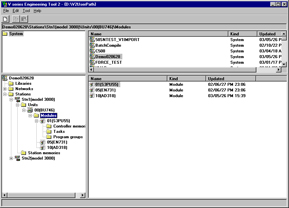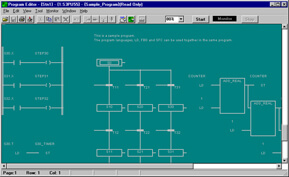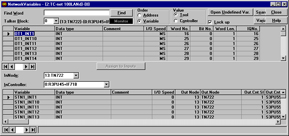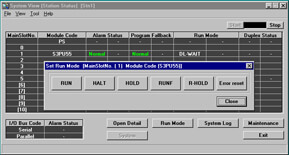We use cookies to support this website, track usage on this website, to perform analytics and to perform promotional activities.
Click here to accept cookies.
TIC's Cookie Policy.
Privacy Policy
Engineering Tool
The engineering tool supports all the phases of a V-series system from system configuration to programming, monitoring RAS information collection, and monitoring.
Information
The execution environment of the Engineering Tool was improved.
- Microsoft® Windows® 7 (Professional / Ultimate)
- The fixed the Engineering Tool version is following.
- Synchro Trend V1.3.0
- Permissive Fault Diagnosis V1.4.0
- New Instrument FB Library (DS) V1.2.0
- Microsoft® Windows® Server 2008 SP1/SP2
- The fixed the Add-in software version is following.
- Engineering tool 3(V-Tool3) V3.13.0
- Engineering tool 2(V-Tool2) V2.17.0
- Synchro Trend V1.1.0
- Permissive Fault Diagnosis V1.2.0
- New Instrument FB Library (DS) V1.1.0
- New Instrument Tag Editor V1.5.0
- Microsoft® Windows Vista®
Microsoft® Windows® XP SP3 - The fixed the Engineering Tool version is following.
- Engineering tool 3(V-Tool3) V3.11.0
- Engineering tool 2(V-Tool2) V2.15.0
- Synchro Trend V1.1.0
- Permissive Fault Diagnosis V1.2.0
- New Instrument FB Library (DS) V1.1.0
- New Instrument Tag Editor V1.5.0
In PC in which Windows Vista® is installed, when the Engineering Tool are installed for the first time, it is necessary to use CD of the above-mentioned version and to install it.
Update file of the Engineering Tool cannot be newly installed in Windows Vista®.
Please obtain the CD from Toshiba corporation without CD of the Engineering Tool. - PC that installed Microsoft® Office 2007 or Microsoft® Office OneNote® 2007.
PC that installed Microsoft® Office 2003 SP3 or Microsoft® Office OneNote® 2003 SP3. - The fixed the Engineering Tool version is following.
- Engineering tool 3(V-Tool3) V3.7.0
- Engineering tool 2(V-Tool2) V2.12.1
Please confirm the following if the error occurs when the station, the unit, and the module, etc. are added with the Engineering Tool.- - The version and service pack of Microsoft® Office.
- - The version and service pack of Microsoft® Office OneNote®.
- - The version of the Engineering Tool.
Engineering tool 2 / Engineering tool 3
Successor to the existing Integrated Controller engineering tool, version 2 and version 3 features improved user interface, added ease of operation, and higher engineering efficiency through reducing program save time.
Engineering tool 2 and Engineering tool 3 will fully justify the true value of the Integrated Controller V series.
The Engineering tool 3 supports full-graphic editor and ST language (Structured Text) editor in addition to all the features of the Engineering tool 2.
Integrated engineering
The engineering tools for the V series assure integrated engineering regardless of system size and control functions (sequence, instrumentation). The S and L modules can be programmed in the same program language. Apart from programming, hierarchical engineering is available from system to controller, involving network and hardware configuration and module parameter setting.
Hierarchical programming in international standard language
The V series conforms to the international standard IEC61131-3 for its programming languages. The three graphical languages LD (Ladder Diagram), SFC (Sequential Function Chart), and FBD (Function Block Diagram) can be mixedly used on a single campus , thus permitting programming along the control flow.
A program can be created function by function, and a common function can be defined as a function block. This makes possible hierarchical programming.
Free variables
The local variables that can be used in a program can be defined without being conscious of data physical addresses, and the same variable name can be defined in two or more programs.
The global variables that can be used in common in two or more programs are of a hierarchical structure involving not only the variables usable in common in modules but also the variables that can be used in common between station modules and the variables usable in common between networks, so that data can be exchanged without being aware of system size.
Effective also for system maintenance
The engineering tool is effective for not only program monitoring, data value display, setting, trace, module status monitor and operation, module history display and other programming operations and system configuration but also for maintenance, thus permitting integrated engineering with a single engineering tool.
Reverse creation function restores and builds a system from controllers
Programs, variables, hardware configuration, and other information can be fetched from the controller by the engineering tool to restore and build a system.1 This reverse creation function facilitates controller maintenance without program and other data in the field.
Group engineering by client/server
The engineering tool may be used not only singly but also in client/server mode. This makes possible the centralized control of data by a server machine and parallel engineering with two or more client machines. This feature is effective for exclusive processing in competitive operations in which two or more clients may simultaneously edit and compile a program, thus assuring efficient group engineering.
Waste-free transition of engineering data
(Engineering tool 2 / Engineering tool 3)
variables and other engineering data can be used by converting them into data for the engineering tool 2 and engineering tool 3, using V1 Import, which is a standard component of the engineering tool 2 and engineering tool 3. Therefore, the data created so far can be shifted to the engineering tool 2 and engineering tool 3 without waste.
Operating conditions
| Hardware | Windows® 2000/Windows NT®4.0: PC/ATcompatible machines: Intel Pentium® 400 MHz or higher (server: Pentium® III 1 GHz or higher) Windows® XP: PC/ATcompatible machines: Intel Pentium® III 1 GHz or higher (server: Pentium® 4 1.7 GHz or higher) Windows Vista®: PC/ATcompatible machines: Intel® Core™2 1GHz or higher (server: Core™2 2GHz or higher) Windows Server® 2003 R2, 2008 SP1/SP2: PC/ATcompatible machines: Intel® Xeon® 3GHz or higher / Intel® Core™2 2GHz or higher |
|---|---|
| OS | Microsoft® Windows® XP (SP1 and up)/Windows®2000 (SP3 and up)/Windows NT® 4.0 (SP6a and up) Microsoft® Windows Vista® Business SP1 Microsoft® Windows Vista® Ultimate SP1 Microsoft® Windows Server® 2003 R2 Enterprise Edition SP2 * V3.11.0 and newer versions are compatible with Windows Vista®. Microsoft® Windows® Server 2008 SP1/SP2 |
| Memory | Windows® 2000/Windows NT®4.0: 128 megabytes or higher (server: 256 megabytes or higher) Windows® XP 384 megabytes or higher (server: 512 megabytes or higher) Windows Vista®/Windows Server® 2003 R2/Windows® Server 2008 SP1/SP2: 1gigabytes or higher |
| CD-ROM drive | Necessary for setup |
| Interface | RS-232C/RS485/Ethernet |
| Hardware | Windows® 2000/Windows NT®4.0: PC/ATcompatible machines: Intel Pentium® 400 MHz or higher (server: Pentium® III 1 GHz or higher) Windows® XP: PC/ATcompatible machines: Intel Pentium® III 1 GHz or higher (server: Pentium® 4 1.7 GHz or higher) Windows Vista®: PC/ATcompatible machines: Intel® Core™2 1GHz or higher (server: Core™2 2GHz or higher) Windows Server® 2003 R2, 2008 SP1/SP2: PC/ATcompatible machines: Intel® Xeon® 3GHz or higher / Intel® Core™2 2GHz or higher |
|---|---|
| OS | Microsoft® Windows® XP (SP1 and up)/Windows®2000 (SP3 and up)/Windows NT® 4.0 (SP6a and up) * V2.4.0 and newer versions are compatible with Windows® XP V2.40 Microsoft® Windows Vista® Business SP1 Microsoft® Windows Vista® Ultimate SP1 * V2.15.0 and newer versions are compatible with Windows Vista®. Microsoft® Windows Server® 2003 R2 Enterprise Edition SP2 Microsoft® Windows® Server 2008 SP1/SP2 |
| Memory | Windows® 2000/Windows NT®4.0: 128 megabytes or higher (server: 256 megabytes or higher) Windows® XP 384 megabytes or higher (server: 512 megabytes or higher) Windows Vista®/Windows Server® 2003 R2/Windows® Server 2008 SP1/SP2: 1gigabytes or higher |
| CD-ROM drive | Necessary for setup |
| Interface | RS-232C/RS485/Ethernet |
Newest Version
| Type Version | Version |
|---|---|
| Standalone (English) | 2.17.1 |
| Client/server (English) | 2.17.1 |
| Type Version | Version |
|---|---|
| Standalone (English) | 3.13.1 |
| Client/server (English) | 3.13.1 |
- Microsoft®, Windows®, Windows NT®, Windows Vista® and Windows Server®are either registered trademarks or trademarks of Microsoft Corporation of the United States and/or other countries.
- The formal name of Windows® is Microsoft® Windows® Operating System.
- Pentium is a registered trademark of Intel Corporation of the United States in the U.S.A. and other countries.
- Other company names and product names herein are trademarks or registered trademarks of the companies concerned.
- The contents are subject to change without notice for design changes or other reasons.
Product Image Gallery
Need a Quote? Have A Question?

Let's talk about your customized solutions and packaged deal options. Fill out the form on the right and our product experts will be in touch shortly!

Welcome to Toshiba International Corporation's Download Site!
Register to view our materials and keep informed with our latest updates.
You may enter your filters below to locate manuals, brochures, software, drawings, and other important documents.
Select a category, choose a Product Family, then select from the list of available documents.
If you encounter any problems or have any questions please contact TIC-Webmaster@toshiba.com
- Tools & Resources
- Resource Library
- Literature & Promotional Request
- Training
- FAQs
- Image Gallery
- Mobile Apps
- Videos
- Service & Warranty
- Where to Buy & Service
- TOSHcare®
- Service Request Forms
- General Warranty & Product Registration
- Motor Warranty Claims Procedure
- Support Contacts
Sign me up to receive future updates about Toshiba products
Yes NoI have read and agree to the Privacy Policy










